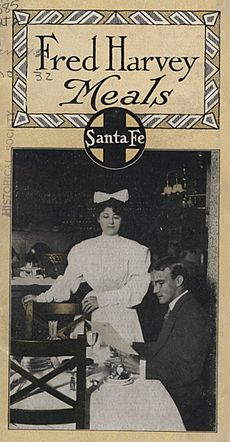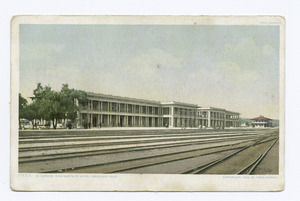Fred Harvey Company facts for kids
The Fred Harvey Company owned the Harvey House chain of restaurants, hotels, and other travel businesses. These were located along railroad tracks in the western United States. Fred Harvey started the company in 1876 to serve the many people traveling by train.
When Fred Harvey passed away in 1901, his family took over 45 restaurants and 20 dining cars in 12 states. During World War II, Harvey Houses reopened to feed soldiers traveling on troop trains. By 1968, when the company was sold, it was the sixth largest food seller in the U.S. The Fred Harvey Company is remembered for its good food, great customer service, fair treatment of employees, and for respecting local traditions.
Contents
A Look Back: The Fred Harvey Story


The company began in 1876 with three railroad eating places in Kansas and Colorado. Fred Harvey, who had moved to the U.S. from England at age 17, opened these cafés. He was a freight agent for another railroad at the time. The first cafés closed within a year, but Harvey saw a big opportunity. He believed people would pay for good food and service at train stops.
His old employer wasn't interested, but the Atchison, Topeka and Santa Fe Railway (AT&SF) gave him a chance. Harvey started by taking over a small lunchroom at their Topeka, Kansas station in January 1876.
In 1878, Harvey opened his first eating house and hotel combined in Florence, Kansas. More Harvey Houses quickly followed. The second one opened in Lakin, Kansas in 1879.
Fred Harvey is known for creating the first restaurant chain in the U.S. His company also helped make the American Southwest a popular place for tourists in the late 1800s. Harvey promoted the area by selling Native American crafts and offering guided tours called "Indian Detours." The company and its employees, especially the famous waitresses known as Harvey Girls, brought better service and dining to what was then called "the Wild West." The Harvey Girls became even more famous in 1946 when Judy Garland starred in the movie The Harvey Girls.
Even as fewer people traveled by train in the 1900s, the company continued to do well. They started serving people traveling by car. After 1926, special "Harvey Cars" were used for the "Indian Detours" tours. Fred Harvey's son, Ford, started these guided trips into the West. The company bought a hotel in Santa Fe, New Mexico, called La Fonda, which became the main office for these tours.
The company kept changing with the times. During World War II, Fred Harvey Houses reopened to feed American soldiers. In 1943, it's thought that the company served over a million meals each month. In the late 1950s, they even ran the new "Oases" rest stops built over the Interstate 294 highway in Illinois.
The Harvey family continued to run the company until a grandson passed away in 1965. Parts of the Fred Harvey Company still operate today. They are part of a larger travel company called Xanterra Parks and Resorts, which was once Amfac, Inc.
Growing Big with the Railroad
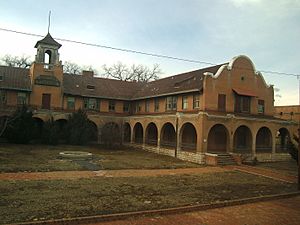
Before dining cars became common on trains, passengers had to eat at roadside stops. The food was often bad, like old meat and cold beans. If passengers didn't have time to stop, they could buy expensive, stale sandwiches on the train platform. These poor conditions made many Americans not want to travel west.
The Fred Harvey Company grew quickly because of its strong connection with the AT&SF Railway. Harvey opened his first restaurant in Topeka, Kansas, in January 1876. Both railroad workers and passengers were very impressed with his high standards for food and service. Before opening, Harvey bought all new silverware, glasses, and dishes. Because of this success, AT&SF made more deals with Harvey. They gave him money to set up a series of "eating houses" along most of their train routes. In bigger towns, these eating houses became hotels. Many of them, like La Posada in Winslow, Arizona, are still around today. By the late 1880s, there was a Fred Harvey dining place every 100 miles along the AT&SF line. This was about how far trains could go before needing more fuel and water.
AT&SF agreed to deliver fresh meat and produce to any Harvey House for free. They used their own special refrigerated train cars for this. Food was shipped from all over the U.S. Sometimes, people would break into the Harvey Houses or the parked refrigerated cars to steal the fresh food. The company also had two dairy farms to make sure they always had fresh milk. When dining cars started appearing on trains, AT&SF hired the Fred Harvey Company to run the food service. All AT&SF ads proudly said, "Fred Harvey Meals All the Way."
Harvey's meals were large and a good value for travelers. For example, pies were cut into fourths, not sixths, which was the usual size. The first customer at the Topeka restaurant got a quarter of an apple pie! The Harvey Company and AT&SF used special signals to help the dining staff. This allowed them to prepare meals for a whole train in just 30 minutes. For instance, the "cup code" let waitresses know what drink was ordered by how the cup was placed on the saucer.
Harvey Houses served meals on fancy china and Irish tablecloths. Fred Harvey was very particular about cleanliness and efficiency. He would inspect his places often and was known to completely flip over a table if it wasn't set perfectly. Male customers often had to wear a coat and tie in many of Harvey's dining rooms. During World War II, Harvey Houses also served meals to soldiers traveling on troop trains.
This strong partnership lasted until 1968. That's when the Fred Harvey Company was sold to Amfac Inc., which is now Xanterra Resorts and Parks.
Hotels and the Grand Canyon
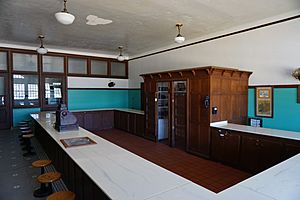
For the Southwest, Harvey hired famous architects like Charles Whittlesey and Louis Curtiss. They designed important hotels in Santa Fe and Gallup, New Mexico. The Grand Canyon was a main tourist spot for the Santa Fe railroad and a big part of the Harvey Company's business. This was especially true after it became a national park in 1919.
The buildings there were designed to fit the rugged landscape and local culture. This style influenced many buildings built in the Western U.S. later on. Mary Colter, an architect for the company from 1904 to 1949, was very important. She made sure her buildings blended with the Grand Canyon's natural beauty. Colter focused on making things look authentic. Hopi House and Bright Angel Lodge, both at the Grand Canyon, are great examples of her work. They helped shape how people thought about "the desert" and Native American culture. Bright Angel Lodge was finished in 1935, during the Great Depression.
The Harvey team, with the Santa Fe railroad's support, created many cultural images. They highlighted the unique art of Native Americans and early Spanish settlers in the area. The buildings on the South Rim of the Grand Canyon are especially notable. These include lodges, souvenir shops, and lookout points. Today, they are listed on the National Register of Historic Places.
Some people believe that Harvey Houses started the idea of the "blue-plate special." This was a low-priced, complete meal served on a blue-patterned plate. An 1892 Harvey menu mentions them, long before the term became widely known. Besides the AT&SF, the Harvey Company also ran dining services for other railways.
AT&SF also had three passenger ferry boats that connected the railroad to San Francisco by water. These ships traveled eight miles across the Bay. The larger two ships, the San Pablo and the San Pedro, had a newsstand and lunch counter. They also had a dining room on the upper deck. Meals, sandwiches, and coffee were served. AT&SF stopped the ferry service in 1933 because of the Great Depression.
The Famous Harvey Girls

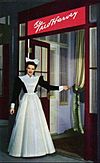
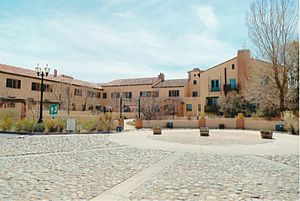
In 1883, Fred Harvey decided to hire only single, well-behaved, and educated young women as waitresses. He placed ads in newspapers across the East Coast and Midwest. He looked for "young women, 18–30 years of age, of good character, attractive and intelligent." These women were paid $18.50 a month, plus a place to live and food. This was a very good income for the time.
The women had strict rules, including a 10 p.m. curfew. A senior Harvey Girl acted as a "house mother" to make sure rules were followed. Their official uniform was a stiff black and white dress. It included a skirt that was no more than eight inches off the floor, special collars, black stockings, and black shoes. Their hair had to be in a net and tied with a white ribbon. No makeup or chewing gum was allowed while working.
Harvey Girls had to sign a six-month work contract. If they left early, they lost half their pay. Getting married was the most common reason for a girl to leave her job.
These rules helped the Harvey Girls keep a good reputation. This also made them seem more desirable for marriage. The famous cowboy Will Rogers once joked that Fred Harvey and his waitresses should be on a coin for feeding the West. For thousands of young women, working as a Harvey Girl was a big step. It allowed them to leave home, travel, and have new experiences. After most Harvey Houses closed, many former Harvey Girls (and their families today) joined groups to celebrate their legacy.
A popular story grew around the Harvey Houses and Harvey Girls. It said these women helped "civilize the American Southwest." This story was told in the 1942 novel The Harvey Girls by Samuel Hopkins Adams. It also inspired the 1946 MGM musical film of the same name, starring Judy Garland.
Dining on the Go
At first, Harvey didn't want to add dining facilities to all AT&SF trains. But eventually, he agreed to help the railroad with this. The California Limited was the first AT&SF train to offer Harvey Company meal service on board. Later trains, like the famous Super Chief, included dining cars staffed by Fred Harvey Company workers from the start. Mary Colter even designed a special china pattern, called Mimbreno, just for the Super Chief's dining cars.
Moving Beyond the Rails
Starting in the 1930s, the Fred Harvey Company began to open restaurants in new places. These were often away from AT&SF train routes. They opened restaurants in places like the Chicago Union Station, the San Diego Union Station, the San Francisco Bus Terminal, and the Albuquerque International Sunport airport. The last one opened at the Los Angeles Union Passenger Terminal in 1939 and could serve almost 300 diners.
From 1959 to 1975, the Fred Harvey organization ran restaurants at the Illinois Tollway Oasis. These were highway rest stops built on bridges over the tollway. In 1954, the Harvey family bought the Grand Canyon hotels from the AT&SF. This made sure the Fred Harvey Company would keep earning money. In 1966, Fred Harvey bought the Furnace Creek Inn near Death Valley National Park. The original Fred Harvey Company and its close link with AT&SF ended in 1968. That's when it was bought by the Amfac Corporation. Amfac was renamed Xanterra Parks & Resorts in 2002. In 2006, Xanterra bought the Grand Canyon Railway and its properties.
Select Harvey Hotels and Facilities
Here is a list of some of the Fred Harvey facilities:
- Airport Marina Hotel in Westchester, Los Angeles (operated by Fred Harvey Co. when it was part of Amfac)
- The Alvarado – Albuquerque, New Mexico; closed in 1970, then torn down.
- Belen Harvey House – Belen, New Mexico; closed in 1939, now a Harvey House Museum.
- The Bisonte – Hutchinson, Kansas; closed in 1946.
- The Casa del Desierto – Barstow, California; closed in 1959, fixed up in 1999, now has two museums and city offices.
- The Castañeda – Las Vegas, New Mexico; closed in 1948, used in the 1984 movie Red Dawn, restored, and reopened in 2019.
- Las Chavez – Vaughn, New Mexico; closed in 1936.
- The Escalante – Ash Fork, Arizona; closed in 1948, torn down in the 1970s.
- La Fonda – Santa Fe, New Mexico; bought by the Santa Fe Railway, leased to Fred Harvey in 1925; still open today with different owners.
- The Fray Marcos – Williams, Arizona; the spot is now The Grand Canyon Railway Hotel, which looks like the old depot.
- El Garces – Needles, California; closed in 1958, restored in 2014.
- Harvey House – Union Station, Los Angeles; designed by Mary Colter, built in 1939, closed in 1967, restored and reopened in 2018 as the Imperial Western Beer Company and Streamliner Bar.
- Harvey House Museum - Florence, Kansas; built in 1876, now a Harvey House Museum.
- The Havasu House – Seligman, Arizona; closed in 1955, torn down in 2008.
- El Navajo – Gallup, New Mexico; closed and torn down in 1957. This building, designed by Mary Colter to honor Native Americans, became a parking lot.
- The Furnace Creek Inn and Ranch in Death Valley (now the Inn at Death Valley).
- El Ortiz – Lamy, New Mexico; closed in 1938.
- El Otero – La Junta, Colorado; closed in 1948.
- La Posada – Winslow, Arizona; closed in 1957; restored and reopened as a historic hotel.
- The Sequoyah – Syracuse, Kansas; closed in 1936.
- The Slaton Harvey House – Slaton, Texas; opened in 1912, restaurant closed in 1942. It was saved from being torn down, renovated, and is now an event center and bed & breakfast.
- El Tovar – Grand Canyon, Arizona; still open. El Tovar's design, by Charles Whittlesey, looks like a Santa Fe-style lodge. It opened in 1905 right on the edge of the Grand Canyon.
- El Vaquero – Dodge City, Kansas; closed in 1948.
Images for kids
-
Judy Garland in a scene from The Harvey Girls.
See also
 In Spanish: Fred Harvey Company para niños
In Spanish: Fred Harvey Company para niños


